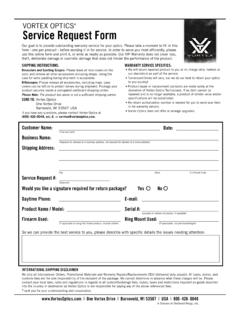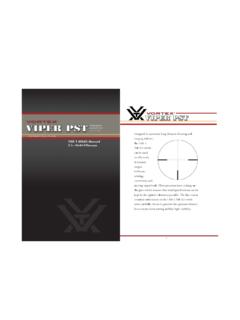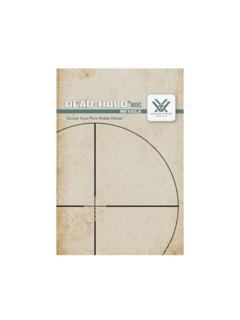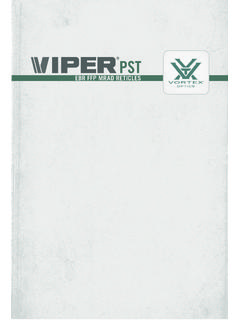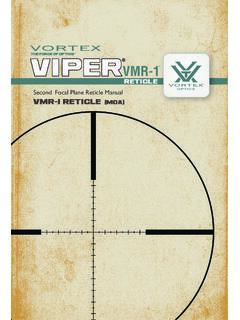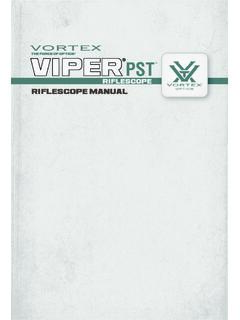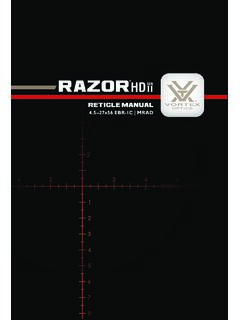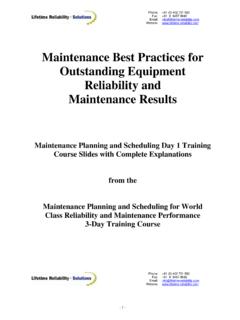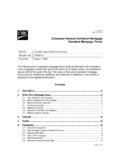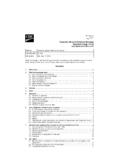Transcription of rIFLESCOPE mANUAL Second Focal Plane | MOA
1 Second Focal Plane | MOArIFLESCOPE mANUALRIFLESCOPEHS-T3 2HS-TRIFLESCOPES pecifically designed for the tactical, law enforcement and committed precision shooting communities, the Vortex Viper HS-TTM rIFLESCOPE offers the highest levels of performance and reliability. With features such as matched turret/reticle subtensions, CRS zero stop mechanisms and precision ranging reticles, the Viper HS-T is ready for any situation. Magnification Adjustment RingWindage Adjustment Knob Reticle Focus Ring ObjectiveLensElevation Adjustment Knob Side Focus KnobThe VorTex Viper hS-TTm rifleScopeFast Focus EyepieceMagView Radius Bar Dual Use: Shooting Tactical / HuntingUS Patent 7,937,8795 4HS-TRIFLESCOPEAll rIFLESCOPE reticles can be termed either first Focal Plane (FFP) or Second Focal Plane (SFP), depending upon their internal location within the rIFLESCOPE . This model features the Second Focal Plane Focal Plane ReticlesSecond Focal Plane (SFP) reticles are located near the scope s eyepiece behind the image erecting and magnifying lenses.
2 This style of reticle does not visually change in size when you change the magnification. The advantage of an SFP reticle is that it always maintains the same ideally-sized appearance when shooting with this SFP scope. Be aware that the listed reticle subtensions used for estimating range, holdover, and wind drift correction are only accurate at the highest opTionSThe Focal PlanerifleScope AdjuSTmenTSThe Viper HS-T rIFLESCOPE uses a fast focus eyepiece designed to quickly and easily adjust the focus on the rIFLESCOPE s reticle. Reticle FocusOnce this adjustment is complete, it will not be necessary to re-focus every time you use the rIFLESCOPE . However, because your eyesight may change over time, you should re-check this adjustment Look through the rIFLESCOPE at a blank white wall or up at the sky. 2. Turn the eyepiece focus knob in or out until the reticle image is as crisp as : Try to make this particular adjustment quickly, as the eye will try to compensate for an out-of-focus reticle.
3 To adjust the reticle focus:WarningLooking directly at the sun through a rIFLESCOPE , or any optical instrument, can cause severe and permanent damage to your the reticle focusVariable Power AdjustmentsTo change the magnification, turn the magnification ring to the desired level. The Vortex fiber optic magnification indicator will provide a low light reference for magnification ScaleMagViewIndicator7 6HS-TRIFLESCOPEThe Viper HS-T rIFLESCOPE features a side focus knob which should be used to fine-tune the image focus. When the image is sharply focused, parallax error will also be Focus and Parallax Correction 1. Be sure the reticle is correctly focused (see Reticle Focus section on page 5). 2. Turn the side focus knob until the target image is as sharp as possible. The yardage numbers referenced on knob should closely match the actual yardage to the Check for parallax error by moving your head back and forth while looking through the scope.
4 The focus is correct if there is no apparent shift of the reticle on the target. If you notice any shift, adjust the focus knob slightly until all shift is the Side FocusParallax is a phenomenon that results when the target image does not quite fall on the same optical Plane as the reticle within the scope. This can cause an apparent movement of the reticle in relation to the target if the shooter s eye is off-centered. Correctly focusing the target image will allow it to fall on the same optical Plane as the reticle within the Viper HS-T rIFLESCOPE incorporates precision finger adjustable elevation and windage dials with audible and Elevation Adjustments1. Turn the adjustment knob in the appropriate direction: Up/Down or Left/Right as indicated by the arrows. 2. Following the directional arrows, turn the knobs in the direction you wish the bullet s point-of-impact to go to. To make adjustments:Turn Side Focus KnobElevationKnobWindage KnobThis Viper HS-T rIFLESCOPE uses finger-adjustable elevation and windage turrets with scales measured in minutes of angle (MOA).
5 MOAs are unit of arc measurements which equal inch for each 100 yards. Examples: inches @ 200 yards, inches @ 300 yards, click of the turret moves the point-of-impact .25 MOA for each 100 yards. For example, .25 MOA equals .26 inches at 100 yards, .52 inches at 200 yards, .78 inches at 300 yards, and so Adjustments9 8HS-TRIFLESCOPEC ustomizable Rotational Stop (CRS)Viper HS-T rIFLESCOPE elevation turrets incorporate the unique CRS rotation stop feature. After the rifle is sighted in, the design of the CRS allows a shooter to quickly and easily return to an original zero point when using the elevation turret to dial-in temporary bullet drop CRS feature is particularly useful when dialing large multi-revolution elevation corrections. Without this feature, the shooter must pay very careful attention when dialing these large corrections. If the shooter loses track of the number of revolutions, the original zero point may become lost when returning the adjustment.
6 The CRS allows the elevation dial to be quickly spun back to original zero without having to carefully count revolutions or clicks. Once the CRS shims are installed after sight-in, the elevation dial will stop turning shortly past the original zero point when being returned (turning clockwise direction) from a temporary elevation adjustment. The shooter can then turn the elevation knob a partial turn in a counter-clockwise direction until the zero reference and radius bar are correctly aligned achieving the original zero CRS shim installation in the Bore Sighting and Final Range Sight-in ShimsTurret RotationThe Viper HS-T rIFLESCOPE incorporates Vortex s patented Radius Bar to visually assist in keeping track of turret rotations. The Radius Bar provides a quick visual reference that allows the shooter to confirm: Knob orientation is correct and has not shifted as a result of accidental contact.
7 Knob orientation is at the zero point when using the CRS feature. By watching the position of the bar while making elevation adjustments, the shooter is able to quickly track full, half and quarter rotations. To get these benefits from the Radius Bar, the 0 mark on the turret must be indexed with the zero reference line on turret post (see Setting the CRS Stop and Indexing Elevation Knob section on page 14).Zero Reference LinesRadius BarTurret CapRetaining Screw11 10HS-TRIFLESCOPEA fter installing the bottom ring halves on the mounting base, place the rIFLESCOPE on the bottom ring halves and loosely install the upper ring halves. Before tightening the scope ring screws, adjust for maximum eye relief to avoid injury from recoil:Eye Relief and Reticle Alignment1. Set the rIFLESCOPE to the middle of its magnification range. 2. Slide the rIFLESCOPE as far forward as possible in the rings.
8 3. While viewing through the rIFLESCOPE in a normal shooting position, slowly slide the rIFLESCOPE back towards the shooter s face paying attention to the field of view. Just as the full view is visible, stop. 4. Without disturbing the front-back placement, rotate the rIFLESCOPE until the vertical crosshair exactly matches the vertical axis of the rifle. Use of a reticle leveling tool, a weight hung on a rope, flat feeler gauges, or bubble levels will help with this procedure. 5. After aligning the reticle, tighten and torque the ring screws down per the manufacturer s bubble levels to square the rIFLESCOPE to the mounTingTo get the best performance from your Viper HS-T rIFLESCOPE , proper mounting is essential. Although not difficult, the correct steps must be followed. If you are unsure of your abilities, it would be best to use the services of a qualified gunsmith. Rings and BasesMount an appropriate base and matching rings to your rifle according to the manufacturer s instructions.
9 The Viper HS-T rIFLESCOPE requires 30 mm rings. Use the lowest ring height that will provide complete clearance of scope and rifle avoiding any contact with barrel, receiver, bolt handle or any other part of the rifle. A low mounting height will help assure proper cheek weld, aid in establishing a solid shooting position, and promote fast target 12HS-TRIFLESCOPEF inal Range Sight-In and CRS Stop SetAfter the rIFLESCOPE has been bore-sighted, final sight-in and CRS stop set should be done at the range using the exact ammunition expected to be used while shooting. Sight in and zero the rIFLESCOPE at the preferred distance. 100 yards is the most common zero distance, although a 200 yard zero may be preferred for long range applications. Be sure the reticle is in focus (see Reticle Focus section on page 5) and adjust the side focus knob if present until the target image is sharp and without parallax error (see Using the Side Focus section on page 7).
10 This procedure can be repeated as many times as necessary to achieve a perfect Following all safe shooting practices, fire a three-shot group as precisely as Next, adjust the reticle to match the approximate center of the shot group (see Windage and Elevation Adjustment section on page 6). Note: If the rifle is very solidly mounted and cannot be moved, simply look through the scope and adjust the reticle until it is centered on the fired group. 3. Carefully fire another three-shot group and see if the bullet group is centered on the SightingInitial bore sighting of the rIFLESCOPE will save time and money at the range. This can be done by using a mechanical or laser bore sighter according to the manufacturer s instructions or by removing the bolt and sighting through the barrel on some Place the rifle solidly on a rest and remove the bolt. 2. Sight through the bore at a target approximately 100 yards Move the rifle and rest until the target is visually centered inside the barrel.
